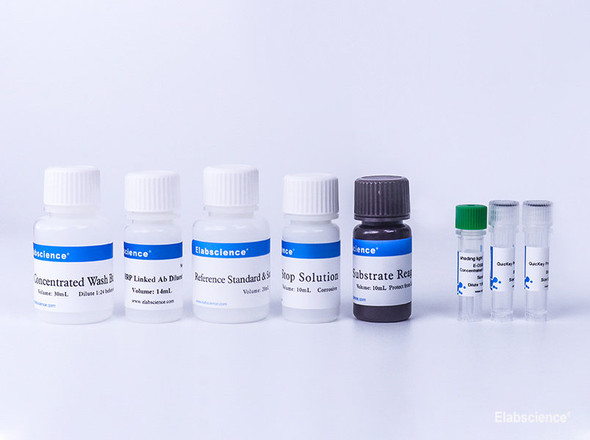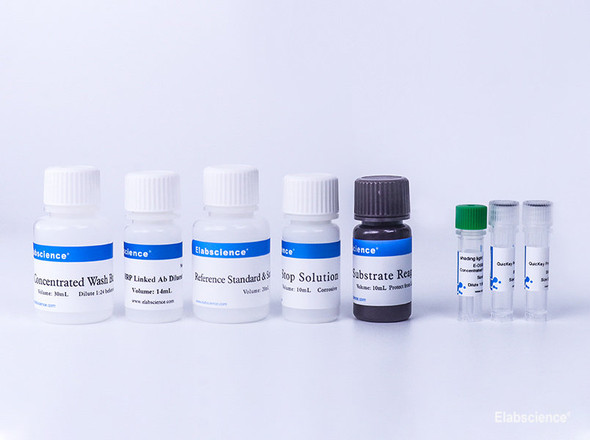Description
T(Testosterone) ELISA Kit Basic Information
|
Product Name |
T(Testosterone) ELISA Kit |
|
Catalog NO. |
FY-EU4332 |
|
Alias |
Testosterone ELISA Kit |
|
Detection Method |
Competitive ELISA, Coated with Antigen |
|
Application |
Testosterone ELISA Kit allows for the in vitro quantitative determination of Testosterone concentrations in serum, plasma, tissue homogenates and other biological fluids. |
|
Size |
48T, 96T |
|
Storage |
2-8 ℃ for 6 months |
|
Sensitivity |
<0.188 ng/ml |
|
Species |
Universal |
|
Uniprot |
|
|
CV %() |
Intra-Assay: CV<8% |
|
Note |
For Research Use Only |
Feiyue's T(Testosterone) ELISA Kit
is an ELISA reagent for detection of T(Testosterone) in serum, plasma or cell with sensitivity, specificity and consistency.
T(Testosterone) Introduction
Testosterone is the primary sex hormone and anabolic steroid in males. In humans, testosterone plays a key role in the development of male reproductive tissues such as testes and prostate, as well as promoting secondary sexual characteristics such as increased muscle and bone mass, and the growth of body hair. In addition, testosterone in both sexes is involved in health and well-being, including moods, behaviour, and in the prevention of osteoporosis. Insufficient levels of testosterone in men may lead to abnormalities including frailty and bone loss. In general, androgens such as testosterone promote protein synthesis and thus growth of tissues with androgen receptors. Testosterone can be described as having virilising and anabolic effects (though these categorical descriptions are somewhat arbitrary, as there is a great deal of mutual overlap between them). Anabolic effects include growth of muscle mass and strength, increased bone density and strength, and stimulation of linear growth and bone maturation.
Androgenic effects include maturation of the sex organs, particularly the penis and the formation of the scrotum in the fetus, and after birth (usually at puberty) a deepening of the voice, growth of facial hair (such as the beard) and axillary (underarm) hair. Many of these fall into the category of male secondary sex characteristics. Testosterone is observed in most vertebrates. Testosterone and the classical nuclear androgen receptor first appeared in gnathostomes (jawed vertebrates). Agnathans (jawless vertebrates) such as lampreys do not produce testosterone but instead use androstenedione as a male sex hormone. Fish make a slightly different form called 11-ketotestosterone. Its counterpart in insects is ecdysone. The presence of these ubiquitous steroids in a wide range of animals suggest that sex hormones have an ancient evolutionary history.
T(Testosterone) ELISA Kit Test method
This kit was based on Competitive-ELISA detection method. The microtiter plate provided in this kit has been pre-coated with target. During the reaction, target in the sample or standard competes with a fixed amount of target on the solid phase supporter for sites on the Biotinylated Detection Antibody specific to target. Excess conjugate and unbound sample or standard are washed from the plate, and HRP-Streptavidin (SABC) is added to each microplate well and incubated. Then TMB substrate solution is added to each well. The enzyme-substrate reaction is terminated by the addition of a sulphuric acid solution and the color change is measured spectrophotometrically at a wavelength of 450nm. The concentration of target in the samples is then determined by comparing the OD of the samples to the standard curve.
Reference:
1, Southren AL, Tochimoto S, Carmody NC, Isurugi K (November 1965). "Plasma production rates of testosterone in normal adult men and women and in patients with the syndrome of feminizing testes". The Journal of Clinical Endocrinology & Metabolism. 25 (11): 1441–50. doi:10.1210/jcem-25-11-1441. PMID 5843701.
2, Dabbs M, Dabbs JM (2000). Heroes, rogues, and lovers: testosterone and behavior. New York: McGraw-Hill. ISBN 978-0-07-135739-5.
Additional Information
Size: |
96T |
Reactivity: |
Universal |
Assay range: |
0.313-20ng/ml |
Sensitivity: |
0.188 ng/ml |












